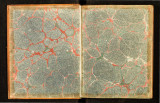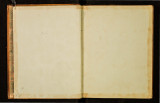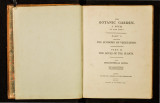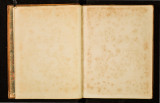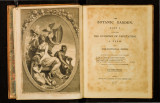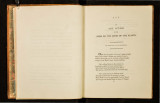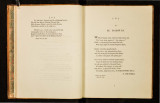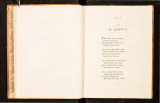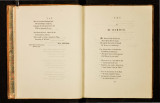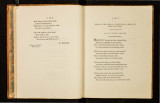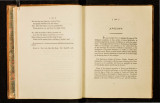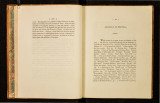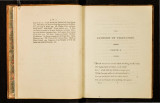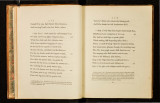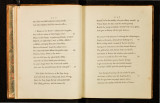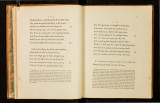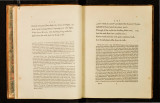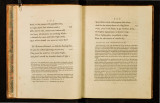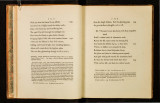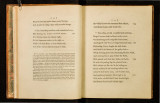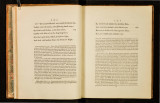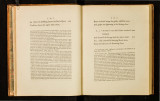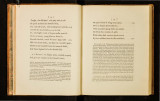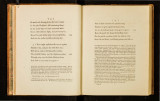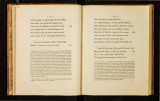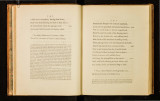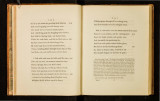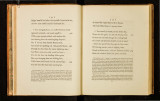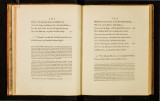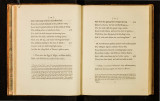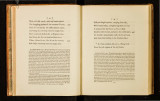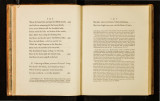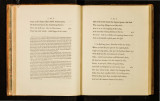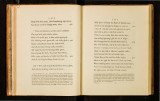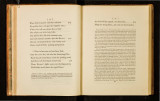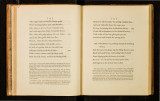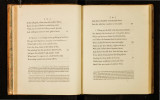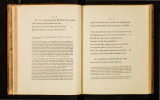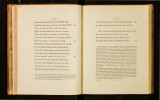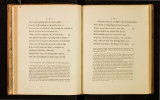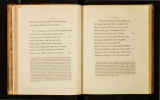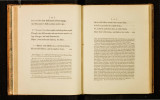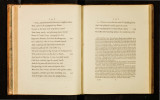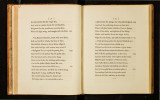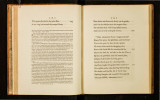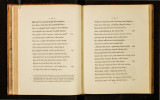| OCR Text |
Show r ~~ J Taught, the firfl: ART! with piny rods to raifc By quick attrition the domefiic blaze, Fan with foft breath, with kindling leaves provide, ~ r 5 And lifl: the dread Defl:royer on his fide. So, with bright vrreath of ferpent-treffes crown'd, Severe in beauty, young MEDUSA frown' d; Erewhile fubdued, round WrsnoM's .lEgis roll'd 219 Hifs' d the dread fnakes, and fla1n' d in burnifh' d gold ; Flaih' d on her brandi{h 'd arm the immortal ihield , And Terror lighten' d o'er the dazzled field. 2. " NYMPHs! You disjoin, unite, condenfe, expand, And give new wonders to the Chemifi' s hand . ' digeilion ; as potatoes, kidney-beans, onions cabbages Th rr. b 1 · ' · e can a va when m d · rea(' IS perhaps rendered mild by the heat it undergoes h a e Into !i fl . . ' more t an by exp ffi · uper uous J utce. The roots of wht"te b . d f re tng Its J yony an o arum I · f, d of their acrimony by boiling. ' am 10 orme lofe much. Young Medufa frown' d. l. 218. The Egyptian Med [; .. with wings on her head fnaky hair d b ·r u a Is reprefented on antient gems . ' ' an a caul! ul counte h" tenfely thmking; and was fuppofed to . {i d" . . nance, w tch appears in-d [; . tepre ent lVIne wtfdo Tl G . u a, on Mmerva's fhield as appea h m. 1e Jrectan Me- ' rs on ot er gems 1 rage or pain, and is fuppofed to reprefent d" . ' las a countenance difiorted" ith h G !VIne vengeance Th" M d r. t e organs, at firll: very beautiful and t "bJ I . . IS e UJa was one of I · · ern e to 1er enet . M" tatr Into fnakcs, and Pcrfeus havt· ff h I mes' merva turned het~ ng cut o cr 1ead fix d ·t h 1v cefs ; the fight of which then petrified the b l ld .De I on t ~ uue]d of that god ... e 10 ers. annet. Dttl. [ 23 ] On tepid clouds of rifing fieam afpire, Or fix in fulphur all its folid fire ; With boundlefs fpring elafl:ic airs unfold, Or fill the fine vacuities of gold ; With fudden flafh vitrefcent fparks reveal, By fierce colli:lion from the flint and fl:eel ; Or fix in Julphur.l. 226. The phenomena of chemical explofrons cannot be accounted for without the fuppofition, that fc>me of the boJies employed contain concentrated or folid heat combined with them, to which the French Chemitl:s have given the name of Calorique. When air is expanded in the air-pump, or water evaporated into fieam, they drink up or abforb a great quantity of heat ; from this analogy, when gunpowder is exploded it ought to abforb much heat, that is, in popular language, it ought to produce a great quantity of cold. When vital air is united with phlogiftic matter in refpiration, which feems to be a !low combufiion, its volume is le!Tcned; the carbonic acid, ;md perhaps phofphoric acid are produced; and heat is given out; which according to the experiments of Dr. Crawford would feem to be depofited from the vital air. But aS' the vital air in nitrous acids is condenfed from a light elafl:ic gas to that of a heavy fluid, it muft po!Tefs lefs heat than before. And hence a great part of the heat, which is given out in firing gunpowder,· I {hould fuppofe, mull: n:fidc- in the fulphur or charcoal. Mr. Lavoifier has fhewn, that vital air, or Oxygene, loofes le(~ of its heat when it becomes one of the component p::rrts of nitrous acid, than in any other of its combinations; and is hence capable of g iving out a great quantity of heat in the cxplofion of gunpowder ; but as there feems to be. great analogy between the matter of heat, orCalorique, and the cleClric l'natter; and as the worft conductors of electricity arc believed to contain the greatell quantity of that fluid; there is reafon to fufpeCl that the worll: conductors of heat may contain the moft of that fluiJ; as fulphur, wax, filk, air, glafs, See note on I. q6 of this Canto. Vi!reficnl jpnrks. I. 229. When flints are fimck againft other flints they have the property of giv ing fparJ...s of light; but it fccms to be an internal light, perhaps of elcCl:ric origin, very different frum the ignited fparks which are {huck from flint and free!. The lpark.~ procll!ced by the colli.fion of lkel with flint appear to be &lobular par.· |



